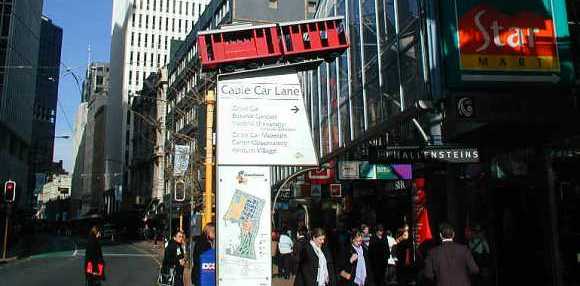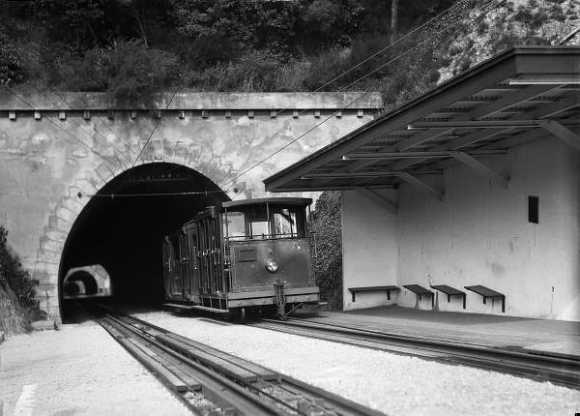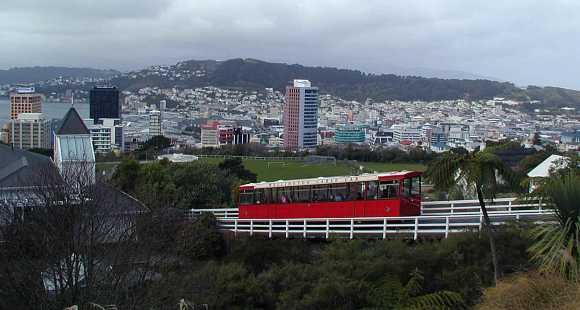|
Zeitblick
- Series
A HillAc Production |
|
City,
My City - Series One Part
5
It is a chilly day in Wellington City. The rain is not too far away and a chill southerly wind ensures that everyone is well wrapped up against the cold. I am standing at the front window of the Kelburn Cable Car waiting for it to begin its ascent to the sky. The driver in my car switches on the single headlight and 612 meters ahead and 120 meters above me an answering headlight flicks on at the front of the descending car. A series of bells followed by a muffled communication over the intercom and we begin our journey upwards. As we ascend, I think back to my childhood when I thrilled with anticipation at the prospect of a ride on the Cable Car. In those days there were outside seats (see pictures of old Cable Car below) - not permitted by today's safety-conscious bureaucrats who seek to protect us from ourselves. One leather hand-strap hanging between two seats ensured we had a safe but exciting ride and one of our childhood delights was to kick the tunnel walls as we travelled through the three tunnels on the journey. The sounds are different too. Back then there was more rattle and clang as we rode the rails to the top whilst today it is a smooth, very low and almost inaudible rumbling, felt through the seat of your pants rather than in Dolby surround-sound.
By 1900, 60 years after it was founded, Wellington's population had reached over 67,000 and the fair city was splitting at the seams. Much of the easily accessible land along the shores and amongst the low hills surrounding the harbour was occupied and, although now part of Wellington, the then distant settlement of Karori was just that, a distant settlement. The only expansion was into the western hills and the farmland of Kelburn Heights was to become valuable urban land as the city sought to expand. The journey from the city to Kelburn, however, was a long and arduous climb and the decision to address this led to the formation of the "Kelburne (the 'e' was later dropped) and Karori Tramway Company". By February 22nd 1902 a double track complete with tunnels, cuttings and viaducts was finished and ready to operate. To the satisfaction of its then owners the cableway was an instant success and passenger numbers were to increase from 425,000 in 1902 to 2,000,000 by 1926. This popularity was never to diminish, even up to the present year and, no doubt, beyond. Its use today remains a mixture of tourist interest and commuter necessity.
The diminutive little Kelburn Cable Cars with their attached carriage-like Trailer Cars continued to operate, virtually unchanged, until 1973 when the first and only accident occurred leading to serious injuries being suffered by a construction worker. The new motorway was ripping through the heart of old Wellington and part of its route passed over the cable car track. The interesting thing about this tragic accident was that it was not caused by the cable car. The worker, employed on building the new motorway, was one of three standing beside the track as the Cable Car approached. He accidentally stepped back into its path and was struck on the legs by the vehicles protruding step. Unfortunately, the Cable Car, too, suffered by this accident. The predictable reaction of the Ministry of Works, the then watchdog of public safety, was to order the removal of the Trailer Cars, which lacked their own braking systems, and to signal the closure of the whole system within 2 years. Also, predictably, the citizens of Wellington demanded the retention of their unique and beloved Cable Cars seeing proposed upgrades as a threat to their continued service. The citizens won.
Following
prolonged discussion, battles and planning, the year 1979 saw the
replacement of these icons of transport with a new and fully automated
system using fully enclosed cars designed and built in Switzerland.
While not having the romance of the original cars, the then Mayor
of Wellington, Sir Michael Fowler, an architect, insisted that the
interior including the seats be finished in natural wood to reflect
the antiquity of the original cars and that the outside, again like
the originals, be painted bright red. By impression, if not in reality,
the romance of the original system continues to be maintained and
the Cable Cars of Wellington will continue trundling up and down
the hill to Kelburn for another 70 years or more. ©
Peter Wells, Wellington, New Zealand
|



